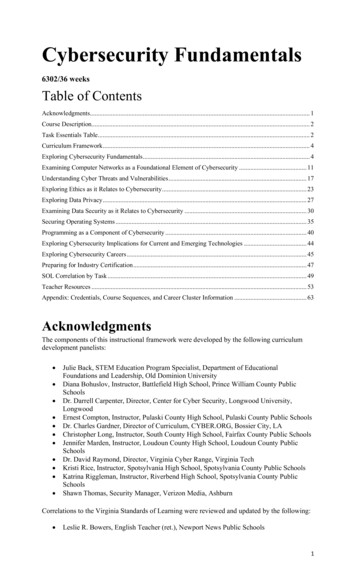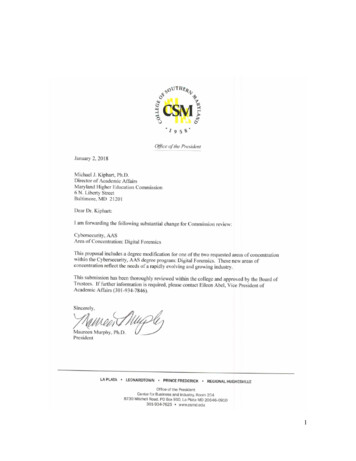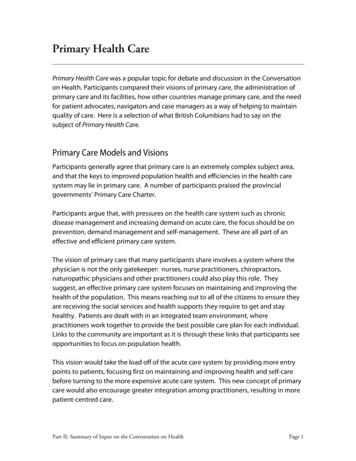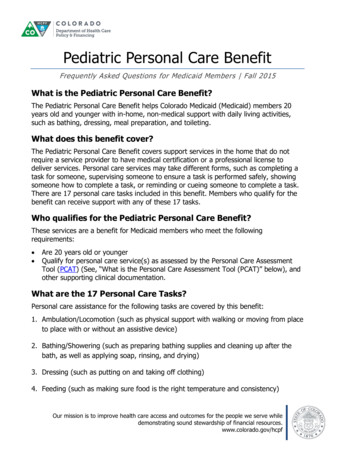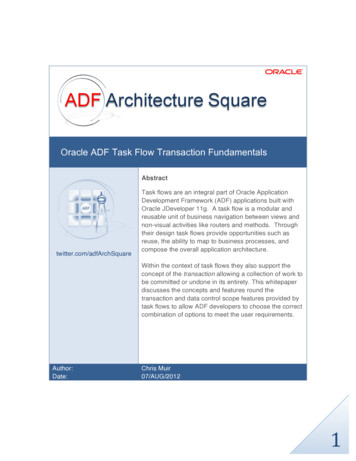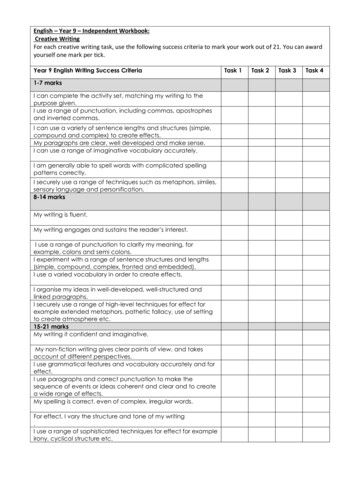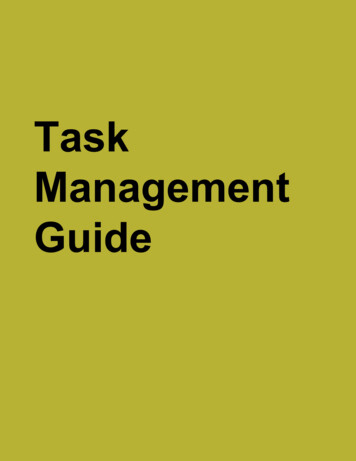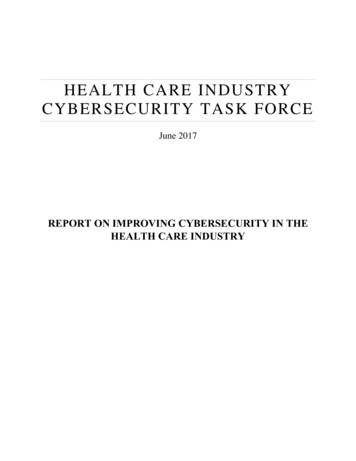
Transcription
HEALTH CARE INDUSTRYCYBERSECURITY TASK FORCEJune 2017REPORT ON IMPROVING CYBERSECURITY IN THEHEALTH CARE INDUSTRY
Members of the Task ForceThe following 21 individuals constitute the membership of the Health Care IndustryCybersecurity Task Force established in March 2016. Task Force Co-Chair Emery Csulak, MS, CISSP, PMP, Chief Information SecurityOfficer, Centers for Medicare and Medicaid Services, U.S. Department of Health andHuman Services Task Force Co-Chair Theresa Meadows, MS, RN, CHCIO, FHIMSS, FACHE, SeniorVice President and Chief Information Officer, Cook Children’s Health Care System Joshua Corman, Co-Founder, I Am The Cavalry George DeCesare, JD, Senior Vice President and Chief Technology Risk Officer, KaiserPermanente Anura Fernando, Principal Engineer, Medical Software and Systems InteroperabilityHealth Sciences Division, UL LLC David Finn, CISA, CISM, CRISC, Health Information Technology Officer, SymantecCorp. Mark Jarrett, MD, MBA, MS, Senior Vice President and Chief Quality Officer, NorthwellHealth and Professor of Medicine, Hofstra Northwell School of Medicine Laura Laybourn, Senior Advisor, Office of Cyber and Infrastructure Analysis, NationalProtection and Programs Directorate, U.S. Department of Homeland Security Michael McNeil, Global Product Security and Service Officer, Philips Healthcare Dan McWhorter, Vice President and Chief Intelligence Strategist, FireEye, Inc. Roy Mellinger, CISSP-ISSAP, ISSMP, CIM, Vice President, IT Security and ChiefInformation Security Officer, Anthem, Inc. Jacki Monson, JD, CHC, CHPC, Vice President, Chief Privacy and Information SecurityOfficer, Sutter Health Ram Ramadoss, MBA, CISA, CISM, CISSP, CRISC, CIPP, Vice President, CRPPrivacy and Information Security and EHR Compliance Oversight, Catholic HealthInitiatives Terry Rice, Vice President, IT Risk Management and Chief Information Security Officer,Merck & Co.HEALTH CARE INDUSTRY CYBERSECURITY TASK FORCEi
Vito Sardanopoli, CISM, CISSP, CISA, Senior Director of Enterprise Security Servicesand Governance, Quest Diagnostics Rob Suarez, Director of Corporate Product Security, BD Kevin Stine, Chief, Applied Cybersecurity Division, Information Technology Laboratory,National Institute of Standards and Technology Christine Sublett, MA, CISSP, CIPT, CRISC, CGEIT, Chief Information SecurityOfficer and Head of Compliance, Augmedix, Inc. Lauren Thompson, PhD, Director, Interagency Program Office, Defense HealthManagement Systems, Department of Defense / Department of Veterans Affairs David Ting, Co-Founder and Chief Technology Officer, Imprivata, Inc. Fred Trotter, Data Journalist, CareSet SystemsThe members of the Health Care Industry Cybersecurity Task Force would like to thank all ofthe individuals and organizations that contributed the development of this report. Contributorsinclude: Stephen Curren, Aftin Ross PhD, MAJ (U.S. Army) William B. Marsh RN, ThadOdderstol, Alissa Johnson PhD., Jason Cameron, Donna Dodson, Ben Flatgard, Kathryn Martin,Nickol Todd, Rose-Marie Nsahlai, Stephen Niemczak, Lucia Savage, Adam Sedgewick, MalikahSmith, Richard Struse, Scott Vantrease, Mark Weber, Nicole Edison, Margie Zuk, Penny Chase,Darren Leitsch, Joanna Centola, Kenneth Trumpoldt, Ryan Marinella, and ChristopherHernandez.The Task Force would also like to express its gratitude to the Department of Health and HumanServices, the Department of Homeland Security, and the National Institute of Standards andTechnology for their work to establish and support the Task Force throughout its efforts.HEALTH CARE INDUSTRY CYBERSECURITY TASK FORCEii
June 2, 2017The Honorable Lamar AlexanderChairmanCommittee on Health, Education, Labor, andPensionsUnited States SenateThe Honorable Greg WaldenChairmanCommittee on Energy and CommerceUnited States House of RepresentativesThe Honorable Ron JohnsonChairmanU.S. Senate Committee on HomelandSecurity and Government AffairsThe Honorable Michael McCaulChairmanHomeland Security CommitteeUnited States House of RepresentativesThe Honorable Richard BurrChairmanSelect Committee on IntelligenceUnited States SenateThe Honorable Devin NunesChairmanPermanent Select Committee on IntelligenceUnited States House of RepresentativesDear Chairman Alexander, Chairman Burr, Chairman Johnson, Chairman McCaul, ChairmanNunes, and Chairman Walden:On behalf of the Health Care Industry Cybersecurity Task Force, we are pleased to submit to youthis Report on Improving Health Care Industry Cybersecurity.The Cybersecurity Act of 2015 provided a much needed opportunity to convene public andprivate sector subject matter experts to spend the last year discussing and developingrecommendations on the growing challenge of cyber attacks targeting health care. Twenty-oneTask Force members contributed to this effort, including 17 from private sector organizations.As public and private sector Co-Chairs of the Task Force, we worked diligently to balanceindustry and government perspectives and to solicit input from outside stakeholders and thegeneral public.The Task Force’s discussions resulted in the development of six imperatives along withcascading recommendations and action items. All of these reflect the need for a unified effort –among public and private sector organizations of all sizes and across all sub-sectors – to worktogether to meet an urgent challenge. They also reflect a shared understanding that for the healthcare industry cybersecurity issues are, at their heart, patient safety issues. As health care becomesincreasingly dependent on information technology, our ability to protect our systems will have anever greater impact on the health of the patients we serve. While much of what we recommendwill require hard work, difficult decisions, and commitment of resources, we will be encouragedand unified by our shared values as health care industry professionals and our commitment toproviding safe, high quality care.HEALTH CARE INDUSTRY CYBERSECURITY TASK FORCEiii
We invite you to join us as we continue to advance this very important mission. We thank youfor your support of the Task Force and look forward to the opportunity to brief you on ourfindings.Sincerely,/s/ Emery Csulak/s/ Theresa MeadowsEmery CsulakCo-ChairChief Information Security Officer andSenior Official for PrivacyCenters for Medicare and Medicaid ServicesTheresa MeadowsCo-ChairSenior Vice President and Chief InformationOfficerCook Children’s Health Care SystemHEALTH CARE INDUSTRY CYBERSECURITY TASK FORCEiv
ContentsMembers of the Task Force . iExecutive Summary . 1I.Health Care Industry Cybersecurity Task Force Charge and Approach. 5II.The State of Cybersecurity within the Health Care Industry . 8III.Risks across the Health Care Industry. 16IV.Imperatives, Recommendations, and Action Items. 21Imperative 1. Define and streamline leadership, governance, and expectations for healthcare industry cybersecurity. . 22Imperative 2. Increase the security and resilience of medical devices and health IT. . 28Imperative 3. Develop the health care workforce capacity necessary to prioritize andensure cybersecurity awareness and technical capabilities. . 35Imperative 4. Increase health care industry readiness through improved cybersecurityawareness and education. . 40Imperative 5. Identify mechanisms to protect R&D efforts and intellectual property fromattacks or exposure. . 47Imperative 6. Improve information sharing of industry threats, risks, and mitigations. 50V.Future Considerations . 54Appendix A: Imperatives, Recommendations, and Action Items. 55Appendix B: Task Force Meeting Agendas and Speakers. 67Appendix C: Resource Catalog. 75Appendix D: Cybersecurity Best Practices from Other Critical Infrastructure Sectors . 83Appendix E: Acronyms. 88HEALTH CARE INDUSTRY CYBERSECURITY TASK FORCEv
Figures and TablesFigure 1 Health Care Cybersecurity Environment. 1Figure 2 Health Care Ecosystem. 8Figure 3 Health Care Regulatory Visualization . 13Figure 4 Health Care Subsector Risks across the Value Chain . 17Figure 5 Resource Mind Map . 75Table 1 Examples of Cybersecurity Risks to Networked Medical Devices and Connected ITnetworks . 18Table 2 Task Force Meeting Dates . 67Table 3 March 16, 2016 Agenda. 67Table 4 April 21, 2016 Agenda. 68Table 5 May 19, 2016 Agenda . 69Table 6 June 16, 2016 Agenda . 69Table 7 July 21, 2016 Agenda . 69Table 8 August 18, 2016 Agenda . 70Table 9 September 15, 2016 Agenda . 70Table 10 October 26-27, 2016 Agendas . 70Table 11 November 17, 2016 Agenda . 71Table 12 December 14-15, 2016 Agendas . 71Table 13 January 12, 2017 Agenda. 73Table 14 January 17, 2017 Agenda. 73Table 15 February 9, 2017 Agenda. 73Table 16 February 20, 2017 Agenda. 73Table 17 March 9, 2017 Agenda. 74Table 18 March 16, 2017 Agenda. 74Table 19 Lessons learned and best practices . 84HEALTH CARE INDUSTRY CYBERSECURITY TASK FORCEvi
This page intentionally left blank.HEALTH CARE INDUSTRY CYBERSECURITY TASK FORCEvii
Executive SummaryThe health care system cannot deliver effective and safe care without deeper digital connectivity.If the health care system is connected, but insecure, this connectivity could betray patient safety,subjecting them to unnecessary risk and forcing them to pay unaffordable personal costs. Ournation must find a way to prevent our patients from being forced to choose between connectivityand security.In the Cybersecurity Act of 2015 (the Act), Congress established the Health Care IndustryCybersecurity (HCIC) Task Force to address the challenges the health care industry faces whensecuring and protecting itself against cybersecurity incidents, whether intentional orunintentional. Real cases of identity theft,Figure 1 Health Care Cybersecurity Environmentransomware, and targeted nation-statehacking prove that our health care data isvulnerable. Data collected for the good ofpatients and used to develop new treatmentscan be used for nefarious purposes such asfraud, identity theft, supply chaindisruptions, the theft of research anddevelopment, and stock manipulation. Mostimportantly, cybersecurity attacks disruptpatient care (References to Figure 1 foundbelow) 1.The health care industry in the UnitedStates is a mosaic, including very largehealth systems, single physician practices,public and private payers, researchinstitutions, medical device developers andsoftware companies, and a diverse andwidespread patient population. Layered ontop of this is a matrix of well-intentionedfederal and state laws and regulations thatcan impede addressing issues acrossjurisdictions. This creates the potential to develop barriers to innovation and ease of use. Withinthis complex network, patients must be protected from harms that may stem from cybersecurityvulnerabilities and exploits.Now more than ever, all health care delivery organizations (including all constituents referred toabove) have a greater responsibility to secure their systems, medical devices, and patient data.Most health care organizations face significant resource constraints as operating margins can bebelow one percent. Many organizations cannot afford to retain in-house information security12013 HIMSS Security Survey - pg 34: Severe Lack of Security Talent; Naked Security, “Windows XP StillWidespread Among Healthcare Providers”: Legacy Equipment; HealthIT.gov, “Meaningful Use Definition &Objective”: Premature / Over-Connectivity; ArsTechnica, “Patients diverted to other hospitals after ransomwarelocks down key software”: Vulnerabilities cause Patient Care Outages; ICS-CERT, “Advisory (ICSMA-16-089-01)CareFusion Pyxis SupplyStation System Vulnerabilities”: Known vulnerabilities epidemicHEALTH CARE INDUSTRY CYBERSECURITY TASK FORCE1
personnel, or designate an information technology (IT) staff member with cybersecurity as acollateral duty. These organizations often lack the infrastructure to identify and track threats, thecapacity to analyze and translate the threat data they receive into actionable information, and thecapability to act on that information. Many organizations also have not crossed the digital dividein not having the technology resources and expertise to address current and emergingcybersecurity threats. These organizations may not know that they have experienced an attackuntil long after it has occurred. Additionally, both large and small health care deliveryorganizations struggle with numerous unsupported legacy systems that cannot easily be replaced(hardware, software and operating systems) with large numbers of vulnerabilities and fewmodern countermeasures. Industry will need to dramatically reduce the use of less defensiblelegacy and unsupported products, and more effectively reduce risk in future products throughrobust development and support strategies.With the exception of IT security personnel, many providers and other health care workers oftenassume that the IT network and the devices they support function efficiently and that their levelof cybersecurity vulnerability is low. Recent high-profile incidents, such as ransomware attacksand large-scale privacy breaches, have shown this vulnerability assumption to be false andprovided an opportunity to increase education and awareness about the benefits of cybersecurityin the health care community. Moreover, recent ransomware incidents have also highlighted howpatient care at health care delivery organizations can be interrupted due to a system compromise.Members of the health ecosystem reported that prior to these breaches many securityprofessionals had difficulty demonstrating the importance of cyber protections to organizationalleadership, including how risk mitigation can save money and protect against reputationaldamage in the long-term. Making the decision to prioritize cybersecurity within the health careindustry requires culture shifts and increased communication to and from leadership, as well aschanges in the way providers perform their duties in the clinical environment.Thus, health care cybersecurity is a key public health concern that needs immediate andaggressive attention. In consultation with the Director of the National Institute of Standards andTechnology and the Secretary of Homeland Security, the Secretary of Health and HumanServices brought together a diverse group of industry representatives to discuss these issues,consistent with the requirements outlined in the Act. Industry participation in the Task Forcebrought to light critical areas for discussion. Some of the topics raised included: Who from the federal government provides cybersecurity leadership and coordinates thepreparedness and response for cybersecurity incidents for the health care sector?(Recommendation 1.1) How does industry organize itself to oversee and promote health care cybersecuritypriorities and share information? (Recommendation 1.4, Recommendation 4.5,Recommendation 6.2) How does the sector leverage the National Institute of Standards and Technology (NIST)Cybersecurity Framework, or other frameworks, as a standard to measure itself, as wellas to design and implement risk management practices? (Recommendation 1.2)HEALTH CARE INDUSTRY CYBERSECURITY TASK FORCE2
What impact does the diversity of regulations have on the ease of adoption ofcybersecurity practices or the ability of industry members to collaborate on cybersecurityissues? (Recommendation 1.3, Recommendation 1.5) How do legacy systems (including medical devices, electronic health records, etc.) affecthealth care industry cybersecurity and how can these systems be made more resilient?(Recommendation 2.1) What are the cybersecurity challenges facing small and rural organizations?(Recommendation 3.3, Recommendation 3.4, Recommendation 6.1) How does supply chain affect the secure development, on-going maintenance, and systemhardening (i.e., managing vulnerabilities in third party software) for medical devices,pharmaceutical manufacturing, and Internet of Things innovation? (Recommendation 2.2,Recommendation 2.3)To identify a wide range of threats that affect the health care industry, the Task Force relied oninformation gathered during public meetings, briefings and consultations with experts on avariety of topics across health care and other critical infrastructure sectors, internal Task Forcemeetings, and responses to blog posts. 2 The Task Force’s activities resulted in the developmentof recommendations that will collectively help increase security across the health care industry.The Task Force identified six high-level imperatives by which to organize its recommendationsand action items. The imperatives are:1. Define and streamline leadership, governance, and expectations for health care industrycybersecurity.2. Increase the security and resilience of medical devices and health IT.3. Develop the health care workforce capacity necessary to prioritize and ensurecybersecurity awareness and technical capabilities.4. Increase health care industry readiness through improved cybersecurity awareness andeducation.5. Identify mechanisms to protect research and development efforts and intellectual propertyfrom attacks or exposure.6. Improve information sharing of industry threats, weaknesses, and mitigations.2The Act identifies members of the health care industry to include: health plans, health care clearinghouses, orhealth care providers; patient advocates; pharmacists; developers of health information technology; laboratories;pharmaceutical or medical device manufacturers; and other additional stakeholders in the definition of health careindustry stakeholders.HEALTH CARE INDUSTRY CYBERSECURITY TASK FORCE3
Each recommendation includes one or more action items for implementing the recommendation.Some recommendations and action items identify a single entity that the Task Force recommendsbe responsible for the recommendation and action items, while other recommendations andaction items recommend multiple entities be responsible for implementation. The successfulimplementation of these recommendations will require adequate resources and coordinationacross the public and private sector. Once implemented, the recommendations will increasesecurity for the health care industry’s organizations, networks, and associated medical devices.See Appendix A for a summary of the imperatives, recommendations, and action items containedin this report.The public-private partnership cultivated by the Task Force, which resulted in the developmentof this report, has provided an opportunity to address significant cybersecurity concerns in thehealth care industry. The Task Force members found this engagement with other federal andprivate sector partners beneficial to understand our common cybersecurity challenges andconcerns. Therefore, we believe the establishment of an ongoing public-private forum wouldserve to enhance cybersecurity discussions and protections as a critical component for the healthcare industry to increase patient safety.HEALTH CARE INDUSTRY CYBERSECURITY TASK FORCE4
I.Health Care Industry Cybersecurity Task Force Chargeand ApproachCybersecurity concerns are bi-partisan and figure prominently into the platforms of both theRepublican and Democratic parties. This was demonstrated when Congress passed theCybersecurity Act of 2015 (the Act). Given the severity of attacks in recent years and the rapiddeployment of information technology (IT) throughout health care, Congress singled out thehealth care industry and required the establishment of the Health Care Industry CybersecurityTask Force (HCIC Task Force or Task Force). Under Section 405 (c), the Act required the TaskForce to accomplish six tasks that culminated in the development and delivery of the TaskForce’s Report on Improving Cybersecurity in the Health Care Industry. Just as the 1999Institute of Medicine report To Err is Human 3 was a call to arms for patient safety, the TaskForce hopes that this report galvanizes both the public and private sectors to comprehensivelyaddress cybersecurity challenges in order to protect patients. Under the Act, the Task Force wasdirected to:(A) analyze how industries, other than the health care industry, have implemented strategiesand safeguards for addressing cybersecurity threats within their respective industries;(B) analyze challenges and barriers private entities (excluding any State, tribal, or localgovernment) in the health care industry face securing themselves against cyber attacks;(C) review challenges that covered entities and business associates face in securingnetworked medical devices and other software or systems that connect to an electronichealth record;(D) provide the Secretary with information to disseminate to health care industrystakeholders of all sizes for purposes of improving their preparedness for, and responseto, cybersecurity threats affecting the health care industry;(E) establish a plan for implementing title I of this division, so that the Federal Governmentand health care industry stakeholders may in real time, share actionable cyber threatindicators and defensive measures; and(F) report to the appropriate congressional committees on the findings and recommendationsof the task force regarding carrying out subparagraphs (A) through (E).To accomplish its mandate the Department of Health and Human Services (HHS), Department ofHomeland Security (DHS), and the National Institute of Standards and Technology (NIST)identified Task Force members representing the federal government, hospitals, insurers, patientadvocates, security researchers, pharmaceutical companies, medical device manufacturers, healthIT developers and vendors, and laboratories. Collectively, the members possess both depth andbreadth of expertise in IT and cybersecurity, clinical medicine, medical device development, and3Institute of Medicine. (1999). To Err is Human: Building a Safer Health System. Retrieved from: Building a SaferHealth System ReportHEALTH CARE INDUSTRY CYBERSECURITY TASK FORCE5
software development. The Task Force’s approach to meeting the Act Section 405 (c)requirements included holding internal meetings at least monthly, engaging the public throughfour public meetings, consulting with experts within health care and other critical infrastructuresectors, and gathering additional insight and information from the public through responses toblog posts. Appendix B summarizes all meetings held by the Task Force.The Task Force received briefings and consultations from experts from other criticalinfrastructure sectors on a variety of topics to understand their strategies and safeguards foraddressing cybersecurity threats. Specifically, the Task Force engaged members of the FinancialServices, Transportation, and Energy Sectors. Despite some similarities between these sectorsand health care, the Task Force realized that if every health care organization were required toimmediately implement the highest level of cybersecurity best practices, many would be forcedto choose between – as one Task Force member stated – procuring new security technologies andrelated subject matter expertise, or purchasing new ventilators and hiring nurses. See AppendixD for documented cybersecurity best practices from other critical infrastructure sectors.Health care data may be used for a variety of nefarious purposes including fraud, identity theft,supply chain disruptions, the theft and sale of proprietary information, stock manipulation, anddisruption of hospital systems and patient care. A significant challenge and vulnerability forproviders, hospitals, pharmaceutical manufacturers, and laboratories includes the ever-increasingvolume of connected medical devices and automated medication delivery systems, which, if notprotected, could pose a risk to patient safety. Industry participation on the Task Force identifiedcritical areas for discussion. Some of the topics raised included: Who from the federal government provides cybersecurity leadership and coordinates thepreparedness and response for cybersecurity incidents for the health care sector?(Recommendation 1.1) How does industry organize itself to oversee and promote health care cybersecuritypriorities and share information? (Recommendation 1.4, Recommendation 4.5,Recommendation 6.2) How does the sector leverage the NIST Cybersecurity Framework, or other frameworks,as a standard to measure itself, as well as to design and implement risk managementpractices? (Recommendation 1.2) What impact does the diversity of regulations have on the ease of adoption ofcybersecurity practices or the ability of industry members to collaborate on cybersecurityissues? (Recommendation 1.3, Recommendation 1.5) How do legacy systems (including medical devices, electronic health records, etc.) affecthealth care industry cybersecurity and how can these systems be made more resilient?(Recommendation 2.1) What are the cybersecurity challenges facing small and rural organizations?(Recommendation 3.3, Recommendation 3.4, Recommendation 6.1)HEALTH CARE INDUSTRY CYBERSECURITY TASK FORCE6
How does supply chain effect the secure development, on-going maintenance, and systemhardening (i.e., managing vulnerabilities in third party software) for medical devices,pharmaceutical manufacturing, and Internet of Things (IoT) innovation?(Recommendation 2.2, Recommendation 2.3)The Task Force discussions highlighted the benefits of engaging in focused conversationsbetween stakeholders across the health care industry; the Task Force encourages the continuedcoordination and cooperation between industry and the federal government.HEALTH CARE INDUSTRY CYBERSECURITY TASK FORCE7
II.The State of Cybersecurity within the Health CareIndustryOrganization of the Health Care IndustryThe Health Care and Public Health (HPH) 4 Sector Coordinating Council and GovernmentCoordinating Council define health care in their 2016 Sector Specific Plan as “large, diverse, andopen It includes publicly accessible health care facilities, research centers, suppliers,manufacturers, and other physical assets. It also includes vast, complex public-privateinformation technology systems required for care delivery and for supporting the rapid, securetransmission and storage of large amounts of health care data.” 5 The HPH Sector representsapproximately nine percent of the total United States (U.S.) workforce. 6 See Figure 2 for adepiction of the sector as documented in the HPH Sector Specific Plan and as discussed by theHCIC Task Force.Figure 2 Health Care Ecosystem4This report references both the health care industry and HPH Sector. Instances of “HPH Sector” refers to allsubsectors as defined in the HPH Sector Specific Plan, and instances of “health care industry” refers to
Task Force Co-Chair Emery Csulak, MS, CISSP, PMP, Chief Information Security Officer, Centers for Medicare and Medicaid Services, U.S. Department of Health and Human Services Task Force Co-Chair Theresa Meadows, MS, RN, CHCIO, FHIMSS, FACHE, Senior Vice President and Chief Information Officer, Cook Children's Health Care System
